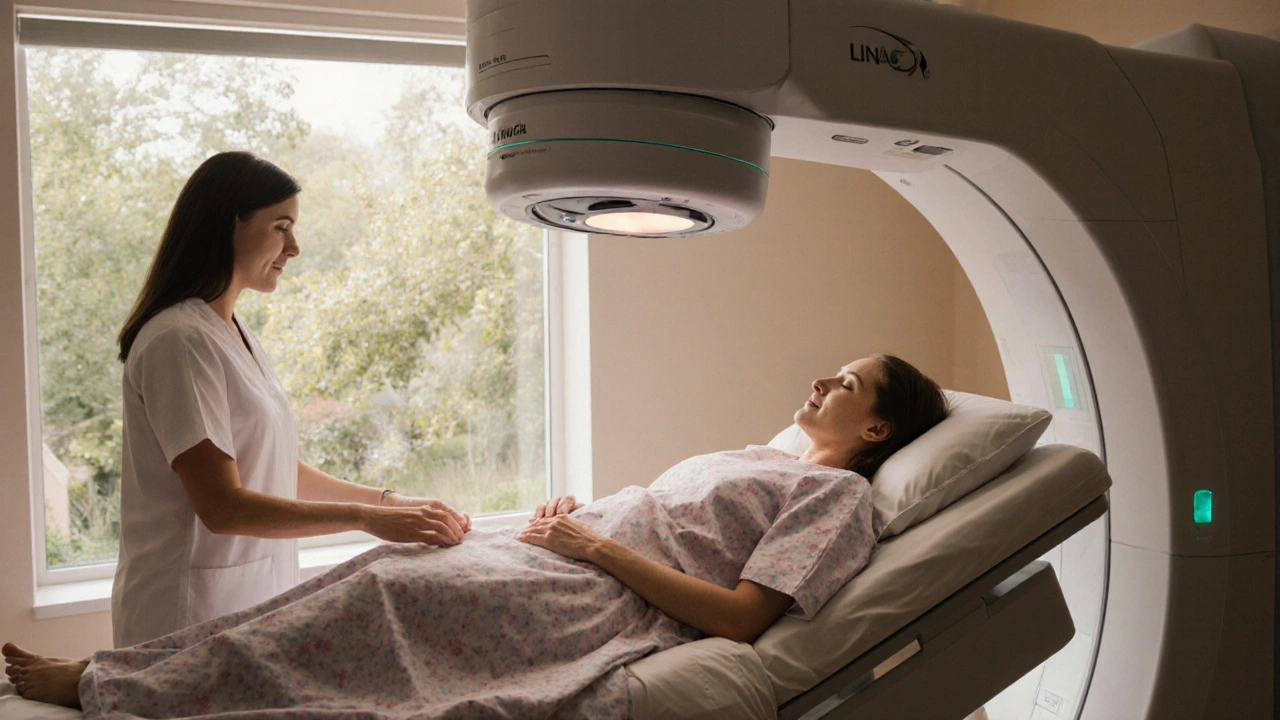Radiation Therapy’s Role in Ovarian Cancer Treatment: What Patients Need to Know
 Sep, 28 2025
Sep, 28 2025
TL;DR
- Radiation therapy is rarely the first‑line option for ovarian cancer but can be crucial after surgery or for recurrent disease.
- It works by delivering high‑energy photons or particles that damage cancer DNA while sparing surrounding tissue.
- External‑beam radiation (EBRT) and brachytherapy are the two main techniques used for ovarian sites.
- Side effects include fatigue, bowel irritation, and rare long‑term risks; most are manageable with supportive care.
- Choosing radiation involves a multidisciplinary team, tumor stage, and the patient’s overall health.
When doctors talk about Radiation Therapy is a treatment that uses high‑energy radiation to kill cancer cells or shrink tumors. It’s a core pillar of modern oncology, but its place in ovarian cancer has unique nuances that many patients don’t hear about until they’re deep into their care journey.
Ovarian cancer, a malignancy arising from the ovaries, often goes undetected until it has spread beyond the pelvis. Because of this late presentation, surgeons aim for cytoreductive (de‑bulking) surgery, followed by platinum‑based chemotherapy. Radiation therapy steps in when surgery can’t remove every last nodule or when the disease returns. Below, we break down how, why, and when radiation joins the treatment mix.
What Exactly Is Radiation Therapy?
Radiation Therapy uses ionizing radiation-usually X‑rays, photons, or particles-to damage the DNA of cancer cells, preventing them from dividing and ultimately causing cell death. The two most common delivery methods for ovarian sites are:
- External‑Beam Radiation Therapy (EBRT): A machine outside the body aims beams at the tumor from multiple angles.
- Brachytherapy: Radioactive sources are placed directly into or near the tumor, delivering a high dose locally.
Both techniques rely on sophisticated imaging-CT, MRI, or PET scans-to map the target and protect nearby organs like the bladder and bowel.
How Ovarian Cancer Stage Guides Radiation Use
Ovarian Cancer is staged from I (confined to ovaries) to IV (distant metastasis). Early‑stage disease (I‑II) typically gets surgery plus chemotherapy, and radiation isn’t standard. However, in advanced stages (III‑IV) or recurrent cases, radiation can:
- Target residual microscopic disease after optimal debulking.
- Palliate symptoms from bulky pelvic or peritoneal implants.
- Consolidate response after second‑line chemotherapy.
When the tumor is isolated to the pelvis or abdomen, a radiation oncologist designs a focused plan to avoid excessive exposure to the gastrointestinal tract.
Designing a Radiation Treatment Plan
The planning process begins with a Treatment Planning CT simulation that maps the patient's anatomy in three dimensions. From there, the radiation oncologist, often aided by a medical physicist, determines the:
- Dosage total amount of radiation measured in Gray (Gy)-commonly 45-50Gy delivered in 1.8‑2Gy fractions over five weeks.
- Target volume (gross tumor plus a safety margin) and organs at risk (OARs) such as the small bowel, kidneys, and spinal cord.
- Technique: intensity‑modulated radiation therapy (IMRT) or volumetric‑modulated arc therapy (VMAT) can sculpt dose around irregular shapes, sparing healthy tissue.
If the tumor is confined to a small area, Brachytherapy delivers a high dose directly to the tumor using implanted radioactive sources, often providing better dose conformity with fewer fractions.
Radiation vs. Surgery & Chemotherapy: A Quick Comparison
| Aspect | Radiation Therapy | Surgery | Chemotherapy |
|---|---|---|---|
| Primary Goal | Local control of residual disease | Remove visible tumor mass | Systemic eradication of microscopic disease |
| Ideal Setting | Post‑operative, recurrent, or unresectable lesions | Early‑stage, good performance status | All stages, especially after surgery |
| Typical Duration | 5-6 weeks (daily fractions) or few days for brachytherapy | Hours to a few days (hospital stay) | 3-6 months (multiple cycles) |
| Side‑Effect Profile | Fatigue, bowel irritation, rare secondary cancers | Infection, wound healing issues, adhesions | Nausea, neuropathy, hair loss, marrow suppression |
| Success Metric | Local recurrence‑free survival | Complete cytoreduction (no visible disease) | Progression‑free survival |
Radiation isn’t a standalone cure for ovarian cancer, but it shines when the goal is to mop up leftovers after surgery or to control isolated recurrences.

Managing Radiation Side Effects
Most patients experience mild to moderate side effects that peak midway through treatment and subside a few weeks after. Common acute issues include:
- Fatigue - often improves with rest and light activity.
- Gastrointestinal upset - anti‑diarrheal meds, low‑fiber diet, and hydration help.
- Skin changes - gentle cleansing, moisturizers, and avoiding sun exposure.
Long‑term risks, though rare, can involve radiation‑induced bowel strictures or secondary malignancies. A Radiation Oncologist monitors these effects, adjusts doses, and coordinates supportive care throughout the treatment course.
Who Benefits Most From Radiation?
Eligibility hinges on a few key factors:
- Residual disease size - lesions <5cm often respond well.
- Performance status - patients who can tolerate daily visits.
- Prior treatments - those who have finished platinum‑based chemo but still harbor localized tumors.
A multidisciplinary tumor board-comprising surgeons, medical and radiation oncologists, radiologists, and pathologists-reviews each case. This collaborative approach ensures radiation is used where it adds the most value.
Future Directions: New Tech & Research
Innovation is pushing radiation toward even greater precision. Proton Therapy uses positively charged particles that deposit most of their energy at a defined depth (Bragg peak), sparing tissue beyond the tumor shows promise for pelvic cancers, though data specific to ovarian cancer are still emerging.
Adaptive radiation-re‑planning the dose based on weekly imaging-helps account for tumor shrinkage and organ movement, potentially reducing bowel exposure.
Clinical trials are exploring combinations of radiation with PARP inhibitors or immunotherapy, aiming to turn a local treatment into a systemic weapon.
Bottom Line
While surgery and chemotherapy remain the backbone of ovarian cancer care, radiation therapy offers a targeted, often under‑used option for clearing residual disease and relieving symptoms. Understanding when and how it fits into the overall plan can empower patients to ask the right questions and collaborate more effectively with their care team.
For anyone navigating this journey, remember that radiation therapy ovarian cancer is a piece of a larger puzzle-one that’s most successful when the whole team works together.
Frequently Asked Questions
Can radiation cure ovarian cancer?
Radiation alone rarely cures ovarian cancer. It is most effective when used after surgery to eliminate leftover cells or to control a localized recurrence.
What are the most common side effects?
Patients typically experience fatigue, mild bowel irritation, and skin reddening in the treated area. Most side effects are manageable with medication and lifestyle adjustments.
How long does a typical radiation course last?
Standard external‑beam therapy runs five days a week for about five to six weeks, delivering around 45-50Gy total. Brachytherapy can be completed in a few sessions.
Is radiation safe for women who want to preserve fertility?
Radiation to the pelvic area can affect ovarian function. If fertility preservation is a priority, discuss options like egg or embryo freezing before treatment, or consider alternative local therapies.
Can radiation be combined with newer drugs like PARP inhibitors?
Early studies suggest that combining radiation with PARP inhibitors may boost tumor kill, especially in BRCA‑mutated cancers. Ongoing trials are evaluating safety and efficacy, so talk to your oncologist about trial eligibility.
Drew Burgy
September 28, 2025 AT 15:05Sure, because the Illuminati's secret plan includes swapping chemo for rays to keep us all dependent.
Jacob Hamblin
October 6, 2025 AT 17:48While radiation can feel intimidating, the fatigue and bowel irritation you mentioned are usually temporary, and staying hydrated plus gentle walks can make a big difference in recovery.
Andrea Mathias
October 14, 2025 AT 20:31Let’s cut the crap – they throw radiation at any tumor they can’t surgically cut out, praying the “advanced stage” label scares you into compliance while the pharma giants line their pockets.
TRICIA TUCKER
October 22, 2025 AT 23:13Hey folks, just a heads‑up – if you’re scheduled for external‑beam, ask the techs about IMRT; it shapes the dose like a laser, sparing your gut more than the old‑school techniques.
Dave Tu
October 31, 2025 AT 00:56It is a misconception that radiation therapy supersedes chemotherapy; in fact, systemic treatment remains the cornerstone for disseminated ovarian malignancies, with radiation serving merely an adjunctive role in select cases.
Johnna Sutton
November 8, 2025 AT 03:39In reference to the preceding assertion, it must be emphasized that the alleged conspiratorial motives lack empirical substantiation, and any suggestion of a clandestine agenda is tantamount to unfounded speculation.
Vinay Keragodi
November 16, 2025 AT 06:21From a planning perspective, the CT simulation captures not only the tumor volume but also the positional relationship to the small bowel, kidneys, and spinal cord; this three‑dimensional dataset enables the physicist to sculpt dose gradients with sub‑millimeter precision. Moreover, adaptive planning can account for organ motion between fractions, ensuring consistent target coverage.
Cassidy Strong
November 24, 2025 AT 09:04Radiation oncologists, armed with sophisticated imaging, meticulously delineate gross tumor volume, clinical target volume, and planning target volume, thereby guaranteeing that the prescribed Gray dose conforms precisely to the intended anatomical region, while shielding the surrounding healthy tissues, especially the gastrointestinal tract, from undue exposure.
Anil Karwal
December 2, 2025 AT 11:47Just a reminder: keep your appointments, follow the dietary guidelines, and you’ll probably get through the treatment without major hiccups.
Suresh Pothuri
December 10, 2025 AT 14:29Regarding the previous commentary, it is evident that radiation is not a panacea; nonetheless, for residual disease confined to the pelvis, it offers a localized concentration of energy that systemic chemotherapy cannot replicate.
Millsaps Mcquiston
December 18, 2025 AT 17:12Radiation can help shrink leftover lumps after surgery, especially when chemo can’t reach them.
michael klinger
December 26, 2025 AT 19:55Imagine the lights dimming in the treatment room, the hum of the machine echoing the battle cries of every cell daring to survive; that is the theater of radiation, where hope and fear perform a delicate duet.
Matt Laferty
January 3, 2026 AT 22:37Radiation therapy for ovarian cancer is typically reserved for cases where surgical margins remain positive.
The decision hinges on a multidisciplinary tumor board assessment that weighs disease burden against patient comorbidities.
Modern linear accelerators deliver photons with energies up to 15 MV, allowing deeper penetration while minimizing surface dose.
Intensity‑modulated radiation therapy (IMRT) divides the beam into dozens of sub‑fields, each weighted to sculpt the dose around critical structures.
Volumetric‑modulated arc therapy (VMAT) further shortens treatment time by rotating the gantry continuously.
Treatment planning CT scans are fused with MRI to improve soft‑tissue delineation, especially for ovarian remnants.
The prescribed dose commonly ranges from 45 to 50 Gray, fractionated into 1.8‑2 Gray per day over five weeks.
Daily image‑guided radiation therapy (IGRT) ensures that organ motion due to bladder filling does not compromise target coverage.
Acute side effects such as fatigue, nausea, and enteritis usually peak midway through the course and subside within weeks of completion.
Nutritional counseling, anti‑diarrheal agents, and gentle exercise are integral components of supportive care during treatment.
Late toxicities, though rare, can include radiation‑induced bowel strictures or secondary malignancies, underscoring the importance of long‑term surveillance.
Brachytherapy, when applicable, delivers a high dose directly to the tumor bed, reducing exposure to surrounding organs.
Clinical trials continue to explore the synergy of radiation with PARP inhibitors and immunotherapy, aiming to enhance local control.
Patient education about the realistic goals of radiation-local disease management rather than cure-is essential for managing expectations.
Ultimately, when integrated thoughtfully into a comprehensive treatment plan, radiation can improve progression‑free survival and quality of life for selected ovarian cancer patients.